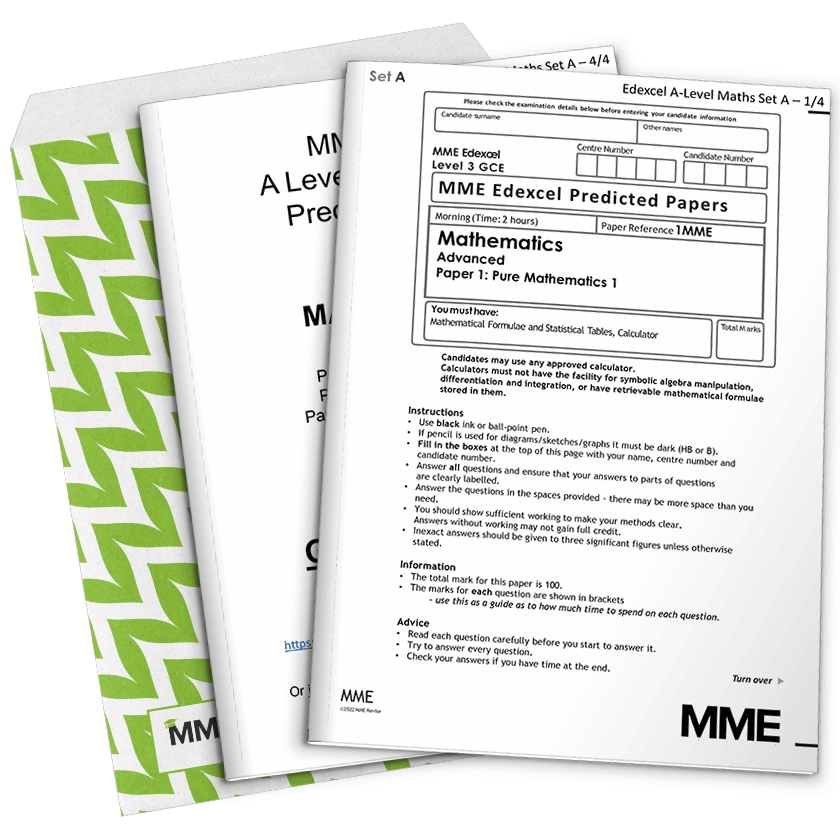Chain Rule
Chain Rule Revision
Chain Rule
The chain rule is best used when we have a function too complex to differentiate in one fell swoop. We look to turn one function into a function of a function – it sounds worse, but I guarantee it will make your job much easier!
Adapting to \dfrac{dx}{dy}
For equations of the form \textcolor{blue}{x} = f(\textcolor{limegreen}{y}), we can calculate \dfrac{d\textcolor{blue}{x}}{d\textcolor{limegreen}{y}} in the same way as usual, and find its reciprocal to find an expression for \dfrac{d\textcolor{limegreen}{y}}{d\textcolor{blue}{x}}. We can then couple this with Integration to find an expression for \textcolor{limegreen}{y} = f^{-1}(\textcolor{blue}{x}), but we’ll not worry about this for the moment.
The most important thing to remember is that \dfrac{d\textcolor{limegreen}{y}}{d\textcolor{blue}{x}} \times \dfrac{d\textcolor{blue}{x}}{d\textcolor{limegreen}{y}} = 1, so we have
\dfrac{d\textcolor{blue}{x}}{d\textcolor{limegreen}{y}} = \dfrac{1}{\left( \dfrac{d\textcolor{limegreen}{y}}{d\textcolor{blue}{x}}\right) }
How to Use the Chain Rule
Let’s say our complex function f(\textcolor{blue}{x}) can be split into a function of a function, i.e. f(\textcolor{blue}{x}) = g(h(\textcolor{blue}{x})).
Then we have the Chain Rule:
\dfrac{df(\textcolor{blue}{x})}{d\textcolor{blue}{x}} = \dfrac{dg(h(\textcolor{blue}{x}))}{d\textcolor{blue}{x}} = \dfrac{dg(h(\textcolor{blue}{x}))}{dh(\textcolor{blue}{x})} \times \dfrac{dh(\textcolor{blue}{x})}{d\textcolor{blue}{x}}
That might still seem a little confusing, so you may see it given where y=g(u) and u = h(x):
\dfrac{dy}{dx} = \dfrac{dy}{du} \times \dfrac{du}{dx}
Connecting Rates of Change
You may see examples where there are several variables linked, for example distance, speed and acceleration or length, surface area and volume. If you know the rate of change of one variable, and the equations linking the variables, then you can use the chain rule to find the rates of change of the other variables.
Watch out for hidden derivatives given as words, such as “rate” or “per“.
Once you understand what the question is asking the calculations are usually pretty straightforward.
Example 1: Using the Chain Rule
Let f(\textcolor{blue}{x}) = \sqrt{2\textcolor{blue}{x} - \dfrac{1}{\textcolor{blue}{x}^2}}. Find the derivative of f(\textcolor{blue}{x}) with respect to \textcolor{blue}{x}.
[4 marks]
Take g(\textcolor{red}{u}) = \sqrt{\textcolor{red}{u}} and \textcolor{red}{u} = h(\textcolor{blue}{x}) = 2\textcolor{blue}{x} - \dfrac{1}{\textcolor{blue}{x}^2}, so f(\textcolor{blue}{x}) = g(h(\textcolor{blue}{x})).
Then,
\dfrac{dg(\textcolor{red}{u})}{d\textcolor{red}{u}} = \dfrac{1}{2\sqrt{\textcolor{red}{u}}} = \dfrac{1}{2\sqrt{2\textcolor{blue}{x} - \dfrac{1}{\textcolor{blue}{x}^2}}} and \dfrac{d\textcolor{red}{u}}{d\textcolor{blue}{x}} =\dfrac{dh(\textcolor{blue}{x})}{d\textcolor{blue}{x}} = 2 + \dfrac{2}{\textcolor{blue}{x}^3} = \dfrac{2\textcolor{blue}{x}^3 + 2}{\textcolor{blue}{x}^3}.
Multiplying the two gives
\dfrac{df(\textcolor{blue}{x})}{d\textcolor{blue}{x}} = \left( \dfrac{2\textcolor{blue}{x}^3 + 2}{\textcolor{blue}{x}^3}\right) \left( \dfrac{1}{2\sqrt{2\textcolor{blue}{x} - \dfrac{1}{\textcolor{blue}{x}^2}}}\right) = \dfrac{\textcolor{blue}{x}^3 + 1}{\textcolor{blue}{x}^3 \sqrt{2\textcolor{blue}{x} - \dfrac{1}{\textcolor{blue}{x}^2}}}
Example 2: Connecting Rates of Change
The surface area of a cube of width x \text{ cm}, length 2x \text{ cm} and height 4x \text{ cm} decreases at a constant rate of 0.07 \text{ cm}^2 \text{s}^{-1}. Find \textcolor{purple}{\dfrac{dx}{dt}} at the point where \textcolor{orange}{x = 5 \text{ cm}}.
[3 marks]
The surface area of the cuboid is:
A = 2 \times (x \times 2x) + 2 \times (x \times 4x) + 2 \times (2x \times 4x) = 28x^2
So,
\dfrac{dA}{dx} = 56x
A decreases at a constant rate of 0.07 \text{ cm}^2\text{s}^{-1}, so we can write this as
\dfrac{dA}{dt} = - 0.07
Now, use the chain rule to find \textcolor{purple}{\dfrac{dx}{dt}}:
\begin{aligned} \textcolor{purple}{\dfrac{dx}{dt}} &= \dfrac{dx}{dA} \times \dfrac{dA}{dt} \\[1.2em] &= \dfrac{1}{\left( \dfrac{dA}{dx} \right)} \times \dfrac{dA}{dt} \\[1.2em] &= \dfrac{1}{56x} \times (-0.07) \\[1.2em] &= - \dfrac{0.00125}{x} \end{aligned}
When \textcolor{orange}{x = 5},
\textcolor{purple}{\dfrac{dx}{dt}} = - \dfrac{0.00125}{x} = - \dfrac{0.00125}{\textcolor{orange}{5}} = -0.00025 \text{ cms}^{-1}
Chain Rule Example Questions
Question 1: Differentiate y = \sin \dfrac{1}{x} with respect to x.
[3 marks]
Let g(u) = \sin u and u = h(x) = \dfrac{1}{x}. Then we have y = g(h(x)).
\dfrac{dy}{dx} = \dfrac{dg(u)}{du} \times \dfrac{du}{dx}\dfrac{dg(u)}{du} = \cos u = \cos \dfrac{1}{x} and \dfrac{du}{dx} = \dfrac{-1}{x^2}
so, \dfrac{dy}{dx} = \dfrac{-\cos \dfrac{1}{x}}{x^2}.
Question 2: For a function x = 3y^2 - 5y + 2, find the values where the function meets the y-axis, and find \dfrac{dy}{dx} at y = \dfrac{2}{3}.
[3 marks]
Set x = 3y^2 - 5y + 2 = 0 to get y = \dfrac{2}{3} and y = 1.
\dfrac{dx}{dy} = 6y - 5
Therefore,
\dfrac{dy}{dx} = \dfrac{1}{6y - 5}
When y = \dfrac{2}{3}, \dfrac{dy}{dx} = -1.
Question 3: A small cubic piece of metal expands when heated. Given that at time t minutes its length is x\text{ cm}, and that the metal expands in all directions with a rate of 0.1\text{ cm min}^{-1}, find an expression for \dfrac{dV}{dt} in terms of x.
[3 marks]
Since the metal is cubic, we have V = x^3.
Therefore, \dfrac{dV}{dx} = 3x^2.
We also have
\dfrac{dx}{dt} = 0.1
so
\dfrac{dV}{dt} = \dfrac{dV}{dx} \times \dfrac{dx}{dt} = 3x^2 \times 0.1 = 0.3x^2
You May Also Like...

MME Learning Portal
Online exams, practice questions and revision videos for every GCSE level 9-1 topic! No fees, no trial period, just totally free access to the UK’s best GCSE maths revision platform.






